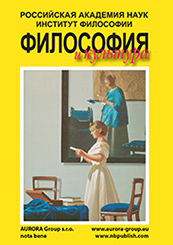Myths and modern mythologies
Reference:
Beskov A.A.
Infiltration of Illusory Ideas About Slavic Paganism into Modern Russian Scientific and Official Business Discourses: Sociocultural Risks
// Philosophy and Culture.
2024. є 7.
P. 1-16.
DOI: 10.7256/2454-0757.2024.7.71122 EDN: GVZGBL URL: https://en.nbpublish.com/library_read_article.php?id=71122
Abstract:
This paper serves as a logical continuation of the article "Fake Science and Simulacra of Culture: Illusory Ideas about Slavic Paganism in Modern Russian Humanities", published in the journal "Voprosy Filosofii" in 2022. This paper was about the mechanism of the origin of illusory ideas about Slavic paganism and the reasons for their intrusion into scientific publications. Here we analyze the socio-cultural consequences that the functioning of this mechanism eventually leads to. The object of study in this article is the modern scientific and parascientific ideas of Russians about the paganism of the ancient Slavs, and the subject of study is the infiltration of parascientific opinions about the ancient SlavsТ paganism in scientific and official business discourses in modern Russia. The methodological basis of the research work is a case study. The methodological arsenal includes also the hermeneutic analysis of a number of texts published in Russian scientific periodicals and serving as material for the author's reflection. In the course of the study, it was revealed that illusory ideas about Slavic paganism very easily infiltrate into various publications presented both in proceedings of the scientific conferences and in scientific journals. As a result, various parascientific (in particular, neo-pagan) constructs gain weight due to their transmission in scientific periodicals. The infiltration of simulacra of traditional culture into scientific discourse leads to the fact that representatives of the scientific community, performing various expert functions, become guides of these simulacra into official business discourse. Given the state's policy of preserving and developing traditional values, it can be expected that under the guise of preserving various folk traditions, modern parascientific constructs that actually have nothing to do with genuine historical and cultural heritage can receive support.
Keywords:
mystical tourism, expert community, Russian academic community, mass consciousness, Parascience, Pseudoscience, Russian Neo-Paganism, Slavic mythology, Slavic paganism, Neo-Nazism
Philosophy and art
Reference:
Pshenichnyi P.V.
The role of holy wives' representations in the Medieval Rus' icons (XVЦXVI centuries) with the main figure of St. Nicholas of Myra and the chosen saints
// Philosophy and Culture.
2024. є 7.
P. 17-30.
DOI: 10.7256/2454-0757.2024.7.71245 EDN: YMNVJQ URL: https://en.nbpublish.com/library_read_article.php?id=71245
Abstract:
In the ancient Russian art of the XVЦXVI centuries, there are often works with the image of St. St. Nicholas of Myra, represented in various iconographic types and accompanied by images of holy wives. These monuments have a similar compositional structure. Among them, the most significant are those icons where the image of the Myrlician saint is placed in the centerpiece, and the figures of selected saints are represented in the margins. The subject of the study in this work is the corpus of monuments with the central image of St. Nicholas as well as the figures of the chosen saints in the fields and the images of female holiness in the margins. The purpose of this article is to determine the role of the figures of the holy women in these icon compositions by the example of monuments of a certain iconographic origin and to offer an interpretation of this previously insufficiently studied plot. To do this, we will resort to the iconographic method of research, which allows us to identify certain nuances of compositional construction, to reveal the spiritual content of the image. The method of comparative analysis is no less important in this work. The works of interest to us are united by the composition of the figures of the few holy women in the lower field, which are associated with evangelical events and the theme of steadfastness in faith (st. Paraskeva, st. Varvara or st. Ulyana), or have pronounced motives for appearing at the Last Judgment (St. Catherine). The stable tradition of depicting these holy women in the iconographic composition of these monuments suggests their correlation with the central image. We believe that they were designed to emphasize the idea of the intercession of the female saints and were organically into iconographic system.
Keywords:
Deesis, saintsТ intercession, St. George, St. Nicetas, St. Catherine, St. Paraskevi, chosen saints, female saints, St. Nicholas of Myra, icon
Philosophy and art
Reference:
Bai D.
Chinese autobiographical documentaries: toward an ethics of filming
// Philosophy and Culture.
2024. є 7.
P. 31-42.
DOI: 10.7256/2454-0757.2024.7.71316 EDN: ZEQYJI URL: https://en.nbpublish.com/library_read_article.php?id=71316
Abstract:
The article is devoted to autobiographical documentaries on the topic of self-therapy, which have been popular in China in the last three years. Using the example of the films "Small Talk" and "Gather before the Jump", the article analyzes how the characters in films with the help of dialogues build their image as "victims of family relations" and completing the plot of self-healing. The author notes that the directors of such films are often too immersed in their own traumatic experiences, to the point that they use the camera as a tool to defend their personal position, and not as a path to self-awareness. They overlook the influence of the passage of time on the validity of traumatic memories and do not monitor equality when communicating with their parents. As a result of the directors' cognitive biases, the representation of traumatic experiences in films is not completely objective. Based on the theory of cognitive psychology and the theory of film psychoanalysis, the author of the article concludes that the discussion of the author's subjectivity should be extended to the subjectivity of his cognitive structure, and not to the personalization of artistic expression. The hypothesis of the study is the assumption that, although such documentaries with a subjective perspective can help the director express his inner feelings, in fact, the arguments given in the author in defense of his personal position. This does not create a general picture of the event; for example, during a film screening in a group, the subjective position of the author forms a unanimous negative attitude among the audience towards the issue of childhood trauma. The article discusses performance, subjectivity and ethical issues that take place in such films. The purpose of the article is to identify the features of this "video practice, which is part of the sphere of everyday life", which distinguish it from other nonЧfunctional narrative practices. The article reveals the methods of documentary film, which allow to bridge the gap between the representation of the film and the actual reality.
Keywords:
intersubjectivity, reflexivity, performance, self-schema, filming behavior, family trauma, director's subjectivity, self-healing, Chinese documentary, autobiography documentary
 This work is licensed under a Creative Commons Attribution-NonCommercial 4.0 International License.
This work is licensed under a Creative Commons Attribution-NonCommercial 4.0 International License.










 © 1998 Ц 2024 Nota Bene. Publishing Technologies. NB-Media Ltd.
© 1998 Ц 2024 Nota Bene. Publishing Technologies. NB-Media Ltd.




